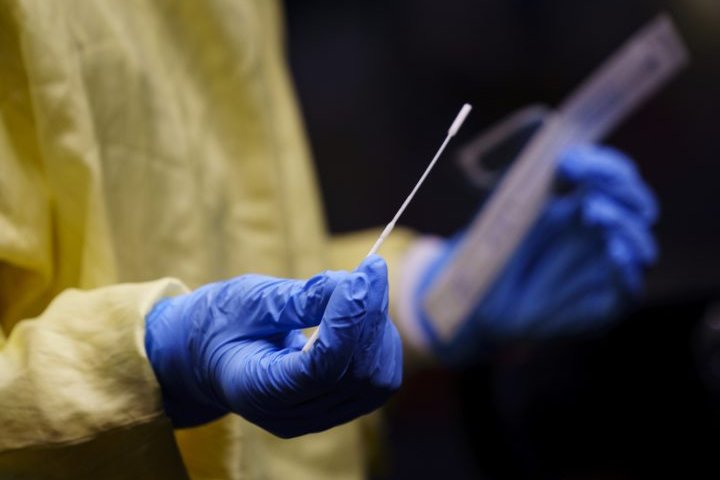Canada’s COVID-19 cases are still falling after Thanksgiving weekend, data shows

Despite fears of a surge in COVID-19 cases following the Thanksgiving long weekend, infections are continuing to fall across most of Canada, according to national data.
The overall positivity rate has also fallen by nearly 50 per cent from the height of the fourth wave in mid-September — suggesting that, despite a drop in testing, fewer people are contracting the virus. The number of active cases has fallen as well.
The declines don’t mean all provinces and territories are out of the woods, however, as health officials are still warning of bursting health-care capacity stemming from the earlier surge.
Yet the data shows that the national outlook is beginning to look sunnier.
Back on Sept. 17, 5,104 new cases were reported across the country out of more than 116,800 tests, a positivity rate of 4.4 per cent.
On Thursday, there were 2,871 new infections, accounting for just 2.8 per cent of the over 101,900 tests performed.
Over two weeks after the Thanksgiving holiday, the seven-day average for new cases is continuing to fall from last month’s peak. It now sits at 2,818 cases per day, marking a 35 per cent drop since Sept. 21.
On Wednesday, the number of active cases nationwide dipped below 30,000 for the first time since Aug. 27. By comparison, there were close to 50,000 active cases at the height of the fourth wave last month.
The decline is a stark contrast from last year’s Thanksgiving, which saw a surge in infections after the holiday despite public health restrictions introduced in the fall.
Health officials at the time explicitly tied the rise in cases to large gatherings held during the weekend, which they had urged Canadians to avoid.
Officials made the same pleas this year due to concerns over the more transmissible Delta variant, which is now the dominant strain of COVID-19 in the country.
Vaccinations appear to have made the difference. Nearly 30 million Canadians — more than three quarters of the total population — have received at least one vaccine dose to date, while almost 28 million people are fully vaccinated.
Although fewer people are getting inoculated than earlier this year, the pace of doses administered saw an uptick in September after many provinces announced proof-of-vaccination mandates for non-essential businesses and services.
The pace has plateaued once again as fewer people remain unvaccinated.
Those unvaccinated people have made up a vast majority of new cases, hospitalizations and deaths across the country.
As of Thursday, 2,290 people were in hospital across the country, a drop of 10 per cent from the peak of over 2,500 two weeks ago. Around 700 people are in intensive care.
Although hospitalizations have begun to decline nationally, Alberta and Saskatchewan are still struggling to administer care to all who need it.
Alberta, which had 201 patients in intensive care Thursday, has more than doubled the normal number of 173 critical care beds and has had to cancel thousands of non-urgent surgeries to handle the surge.
After reporting over 1,000 hospitalizations per day last month, the number has since dipped just below that threshold this week.
The province’s chief medical officer of health Dr. Deena Hinshaw said cases are declining, but warned that the hospital situation remains precarious given the high number of patients.
Meanwhile, Saskatchewan continues to have the highest weekly death rate among the provinces, and has started transferring patients to Ontario as hospitals run out of beds and staff.
Chief medical health officer Dr. Saqib Shahab cried Wednesday when he released COVID-19 modelling that showed hospitalizations would continue to increase until December unless restrictions such as reduced gathering sizes are reintroduced.
The provinces were the first to fully lift public health restrictions this summer, and were slow to introduce vaccine mandates. Some areas in both jurisdictions have also lagged behind the provincial vaccination rates.
The Northwest Territories has also seen a decline in cases after seeing its own surge over the past couple of months. The Canadian Red Cross and other federal agencies have deployed to the territory to help combat the virus’ spread.
Nine people have died since August in the territory, which had yet to see a single death over the first year-and-a-half of the pandemic.
Nationwide, around 40 people are dying from COVID-19 per day on average.
With Halloween around the corner, health officials are once again reminding Canadians to abide by current health restrictions and get vaccinated to keep cases from rising again.
“This is not the year for large Halloween parties,” Hinshaw said Friday.
They say this is also important as the regular flu season begins in order to ensure health-care capacity is freed for those cases.
Experts are predicting a resurgence in influenza this year after being “virtually non-existent” in 2020 due to COVID-19 restrictions, Canada’s chief public health officer Dr. Theresa Tam said Friday.
“This is definitely not the year to have influenza wreak havoc,” Tam said.
–With files from the Canadian Press
by Global News







